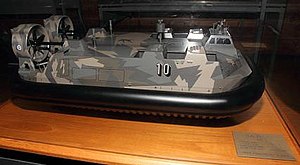| This article relies largely or entirely on a single source. Relevant discussion may be found on the talk page. Please help improve this article by introducing citations to additional sources. Find sources: "Finnish hovercraft Tuuli" – news · newspapers · books · scholar · JSTOR (April 2014) |
 Scale model of FNS Tuuli Scale model of FNS Tuuli
| |
| History | |
|---|---|
| Name | Tuuli |
| Owner | |
| Ordered | 9 July 1999 |
| Builder | Aker Finnyards, Rauma, Finland |
| Completed | 10 June 2002 |
| Commissioned | Never entered active service |
| Stricken | 19 December 2003 |
| Homeport | Upinniemi |
| Fate | Broken up in 2013 |
| General characteristics | |
| Type | Hovercraft |
| Displacement | 84 tons |
| Length | 27.4 m (90 ft) |
| Beam | 15.4 m (51 ft) |
| Draught | - |
| Installed power | 2 × Vericor TF40 gas turbines (6,000 kW) |
| Propulsion | Two air propellers |
| Speed | 50 knots (93 km/h; 58 mph) |
| Complement | 10 |
| Sensors and processing systems | |
| Armament |
|
Tuuli was a hovercraft built for the Finnish Navy. Originally intended to be the lead vessel of a class of four combat hovercraft, she was never officially commissioned and after having been laid up for the most of her career, she was broken up in 2013.
Development
Tuuli was built at the Aker Finnyards Rauma shipyard in Rauma, Finland. Named after a decommissioned Tuima-class (modified Soviet OSA-II) missile boat, she was intended to be the lead vessel of a class of four combat hovercraft that would form part of Squadron 2000 (Finnish: Laivue 2000), a vessel procurement program of the Finnish Navy. Before naming, the hovercraft were referred to as the T-2000 class.
The hovercraft were intended to be used as mobile missile platforms that would be able to navigate and perform surprise attacks in the fractured Finnish archipelago. It was an attack vessel, not a landing craft or transport. Since the seas around Finland usually freeze over in the winter, parts of the archipelago cannot be navigated by conventional surface combatants and are accessible only by air or with a hovercraft. The Finnish Border Guard operates patrol and search-and-rescue hovercraft in these water. However, the focus of the Finnish Navy was redefined as long-term protection of merchant marine traffic, and Hamina-class missile boats with better operational-endurance were selected in Tuuli's stead. As a result, only the prototype vessel was built and never officially commissioned.
Tuuli was completed in 2002. Her trial runs proved a success and her specified capacity and maximum speed were exceeded. On 19 December 2003, it was announced that the Tuuli class would not enter active service and the prototype vessel would be presented for sale. There was foreign interest towards purchasing Tuuli, but no further details have been given. Apparently, Tuuli ACV could have been used in the Arctic to support larger hulls. The vessel was stored at the Upinniemi base.

On 10 July 2013, it was announced that Tuuli would be scrapped as no suitable buyer has been found. She was broken up in October 2013.
Design
The design of the vessel involved technology transferred from the United States. It was constructed from welded panels of thin marine aluminium sheets and extrusions connected with light-weight composite constructions. The special features of the vessel were good mobility, independence of waterways and fixed port equipment, year-around operation and a small crew of only ten owing to the advanced technology.
References
- . Gray, Christopher; Bergey, Leif; and Berbrick, Walter A., "Fleet Arctic Operations Game" (2011). Game Reports. 17. Retrieved 2018-03-10.
- Merivoimat luopuu kahdesta aluksestaan. Turun Sanomat, 10 July 2013. Retrieved 2013-07-10.